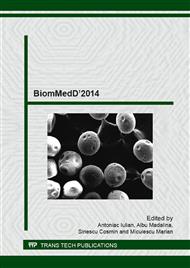[1]
G.J. Puskas, B.F. Morrey, J. Sanchez-Sotelo, Aseptic loosening rate of the humeral stem in the Coonrad-Morrey total elbow arthroplasty. Does size matter? J. Shoulder Elbow Surg. 23 (2014) 76-81.
DOI: 10.1016/j.jse.2013.08.025
Google Scholar
[2]
R. Dee, Total replacement arthroplasty of the elbow joint for rheumatoid arthritis: two cases. Proceedings of the Royal Society for Medicine, vol 63 (1970) 653-655.
DOI: 10.1177/003591577006300701
Google Scholar
[3]
S.E. Park, J.Y. Kim, S.W. Cho, S.K. Rhee, S.Y. Kwon, Complications and revision rate compared by type of total elbow arthroplasty, J. Shoulder Elbow Surg. 22 (2013) 1121-1127.
DOI: 10.1016/j.jse.2013.03.003
Google Scholar
[4]
W.H. Seitz Jr., H. Bismar, P.J. Evans, Failure of the hinge mechanism in total elbow arthroplasty, J. Shoulder Elbow Surg. 19 (2010) 368-375.
DOI: 10.1016/j.jse.2009.11.004
Google Scholar
[5]
P. Mansat, N. Bonnevialle, M. Rongieres, M. Mansat, P. Bonnevialle, Experience with the Coonrad-Morrey total elbow arthroplasty: 78 consecutive total elbow arthroplasties reviewed with an average 5 years of follow-up. J. Shoulder Elbow Surg. 22 (2013).
DOI: 10.1016/j.jse.2013.07.042
Google Scholar
[6]
H.C. Plaschke, T.M. Thillemann, S. Brorson, B.S. Olsen, Implant survival after total elbow arthroplasty: a retrospective study of 324 procedures performed grom 1980 to 2008, J. Shoulder Elbow Surg. 23 (2014) 829-836.
DOI: 10.1016/j.jse.2014.02.001
Google Scholar
[7]
P. Mansat, N. Bonnevialle, M. Rongieres, M. Mansat, P. Bonnevialle, Results with a minimum of 10 years follow-up of the Coonrad/Morrey total elbow arthroplasty. Orthop. Traumatol. Surg. Res. 99 (2013) S337-S343.
DOI: 10.1016/j.otsr.2013.07.002
Google Scholar
[8]
B.T.S. Fevang, S.A. Lie, L.I. Havelin, A. Skredderstuen, O. Furnes, Results after 562 total elbow replacements: A report from the Norwegian Arthroplasty Register, J. Shoulder Elbow Surg. 18 (2009) 449-456.
DOI: 10.1016/j.jse.2009.02.020
Google Scholar
[9]
T.W. Duerig, A.R. Pelton, TiNi Shape Memory Alloys, in: G. Welsch, R. Boyer, E.W. Collings (Eds. ), Materials Properties Handbook: Titanium Alloys, ASM International, Materials Park, 1994, pp.1035-1048.
Google Scholar
[10]
G.E. Welsch, Y.T. Lee, Ti-6Al-4V, in: G. Welsch, R. Boyer, E.W. Collings (Eds. ), Materials Properties Handbook: Titanium Alloys, ASM International, Materials Park, 1994, pp.483-636.
Google Scholar


